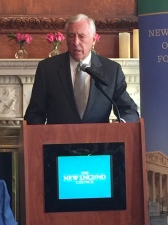 “How many parents here want their kids to grow up to be welders?” House Minority Whip Steny Hoyer asked yesterday morning’s gathering of The New England Council. Not a hand went up. But Hoyer had a point to make. Many welders are enjoying six-figure incomes and making things that matter. That’s a lot better than what some some liberal arts graduates are making, still living at home with their parents. We have to recognize that many students have great abilities but just not in traditional college settings. Our task, Hoyer points out, involves not just creating training but accepting the idea that not every high school student needs or should go to a four-year college.
“How many parents here want their kids to grow up to be welders?” House Minority Whip Steny Hoyer asked yesterday morning’s gathering of The New England Council. Not a hand went up. But Hoyer had a point to make. Many welders are enjoying six-figure incomes and making things that matter. That’s a lot better than what some some liberal arts graduates are making, still living at home with their parents. We have to recognize that many students have great abilities but just not in traditional college settings. Our task, Hoyer points out, involves not just creating training but accepting the idea that not every high school student needs or should go to a four-year college.
As Hoyer tours the country plying his political trade (raising money for Democrats), he makes it a point to visit places that are making something. He readily acknowledges that many American manufacturing jobs have been lost to lower wages overseas. Others have been lost due to changing technology. Our mindset has been that manufacturing jobs are “dark, dirty, dangerous and declining.” Look at the 21st century factory, he urged. It’s sleek. You could eat off the floor. Robots have replaced people, reducing today’s work forces by 80 percent. But while productivity is up, jobs and salaries are not. “This election is all about whether we can have the number and kinds of jobs that will support a middle class lifestyle.”
Stoyer thinks we can, but our education needs to turn out the kinds of workers that the manufacturing sector needs. That means a larger role for community colleges. And, he said, Democrats, always the party of employees, must also become the party of employers. That means increasing access to capital for entrepreneurs, creating tax incentives and simplifying (but not gutting) regulations. It especially means promoting partnerships between manufacturing and education. America, he says, is already the capital of invention, innovation and development. We also have to make it easier for American companies to take these developments to scale here. Hoyer praised The New England Council’s efforts to further advanced manufacturing.
Hoyer is traveling the country pushing his “Make It In America Plan.” Hillary Clinton and Donald Trump are also campaigning on the jobs issue, but their substantive approaches are different, and neither has gotten into the weeds on rebuilding manufacturing and lifting people back to solid middle class status. She takes a traditional Democratic Keynesian approach and talks about funding infrastructure (the “biggest investment in jobs since World War II”), including roads, bridges, broadband and more, plus reducing student costs. Like Hoyer, she says that “a four-year degree shouldn’t be the only path to a good job in America.” She also talks about “making trade work for us not against us.” Trump, for his part, attacks globalization and pledges to stop the Trans Pacific Partnership and renegotiate NAFTA, “the fastest route to more jobs.” He doesn’t specify how. His slogans also include the need to cut taxes and regulations.
Hoyer’s is a comprehensive approach, but, given the makeup of Congress, it seems likelier to succeed in a piecemeal way. (Since 2010, some parts have passed, including small business loans, patent reforms, job training, and ending some of the loopholes that encourage companies to ship jobs overseas.)
While the Democrats might regain control of the Senate, Hoyer admits turning the House is a real reach. (Gerrymandering has locked in too many districts.) Even if the Democrats net just 20 seats, they would still have ten fewer than needed to discharge a bill from committee. Still, Hoyer insists that gain would provide the new House more leverage to put together a deal with moderate Republicans. That any highly-placed legislator thinks this may become possible is a breath of fresh air in the midst of a dispiriting campaign that holds promise for still more deadlock in 2017.
I welcome your comments in the section below. To be alerted when a new blog is posted, click on “Follow’ in the lower right portion of your screen.